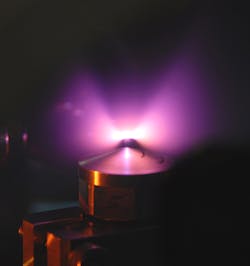Laser-produced electrons show promise in biomedical X-ray development
Laser physicists have, for the first time, succeeded in real-time observation of laser-accelerated fast electron swarms in conjunction with a plasma wave consisting of positively charged helium ions and slow background electrons. The findings will help development of new X-ray sources with much higher resolution than current devices allow for biomedical applications, as well as facilitate development of new electron and light sources for exploring the structure of atoms and molecules.
When short laser pulses irradiate helium atoms, for example, their structure is heavily disturbed. If the light is strong enough, electrons are pulled out of the atoms and the helium atoms become ions. This mixture of electrons and ions is called plasma, which may support wave structures when exposed to strong light. In laser physics, this process and these waves are used under special conditions to rapidly accelerate a small number of the electrons to close to the speed of light and to control them.
In the laser physicists' experiments, they focused a laser pulse, which lasts a few femtoseconds, on a helium gas jet from a specially designed nozzle. The flash of light consists of only a few wave cycles and around one billion photons. Its highest power is focused to a very short moment—the duration of the flash of light—and a tiny area. The high-intensity laser pulse tears out all the electrons from the atoms, leaving behind a plasma composed of free electrons and helium nuclei. In this combination, the electrons are much lighter than the helium ions; as a result, they are pushed aside. While the laser pulse sweeps across the system, the ions remain stationary and the released electrons oscillate around one location. Together, the particles form a plasma wave; one oscillation of this structure takes around 20 fs.
In the plasma wave, gigantic electric fields are formed, which are 1,000 times stronger than those generated in the world’s largest particle accelerators. A small number of the electrons take advantage of these fields, fly as a swarm behind the laser pulse in its slipstream and accelerate to close to the speed of light. In this process, every accelerated electron has almost the same energy.The laser physicists from Garching succeeded in recording both phenomena with a high-resolution image of the plasma wave. The process was documented in snapshots with the same light pulse also responsible for accelerating the electrons. The physicists had previously split the laser pulse so that a small portion of it illuminated the system of free electrons and ions perpendicularly to the electron beam. The periodic structure of the plasma wave refracts and partially deflects the light.
“We observe the deflection and thereby image the plasma wave as a modulation of brightness onto a camera,” explains Laszlo Veisz, the research group leader of the Laboratory of Attosecond Physics (LAP) team. In doing so, the researchers achieve a unique spatial and temporal resolution in the femtosecond range. The electron swarm produces strong magnetic fields that the physicists also record and thus determine its position and duration. Eventually, a film describing the acceleration of the electrons results from the combination of both measurement methods.
The team of laser physicists includes Ferenc Krausz and his employees Laszlo Veisz and Alexander Buck of the Laboratory of Attosecond Physics at the Max Planck-Institute of Quantum Optics (Garching, Germany) and Ludwig Maximilian University (LMU; Munich, Germany), respectively, in cooperation with colleagues from the Friedrich Schiller University Jena (Jena, Germany).
The team describes the results of their work in the March 13 issue of Nature Physics.
-----
Subscribe now to Laser Focus World magazine; it's free!

